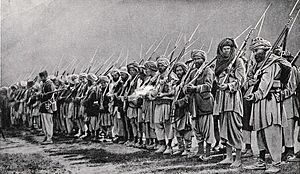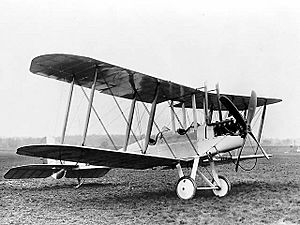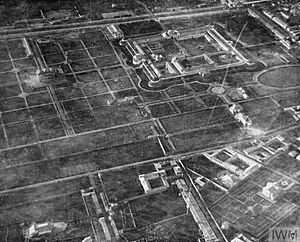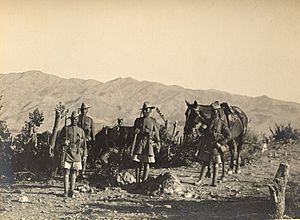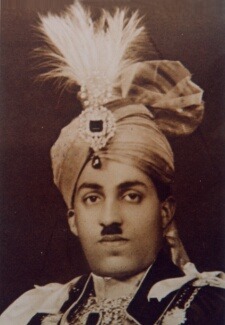Third Anglo-Afghan War facts for kids
Quick facts for kids Third Anglo-Afghan War |
|||||||
|---|---|---|---|---|---|---|---|
| Part of the Interwar period | |||||||
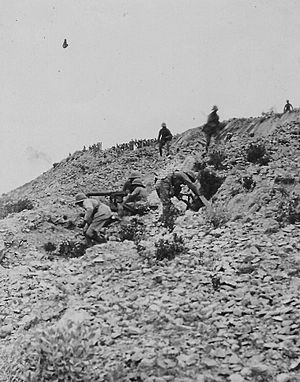 Soldiers in action at Kohat during the Third Anglo-Afghan War |
|||||||
|
|||||||
| Belligerents | |||||||
|
|
|||||||
| Commanders and leaders | |||||||
|
|||||||
| Strength | |||||||
| 50,000 man standing army supported by up to 80,000 tribesmen | 8 divisions 5 independent brigades 3 cavalry brigades, plus a number of modern aircraft, armoured cars and artillery |
||||||
| Casualties and losses | |||||||
| 1,000 to 1,200 killed. Estimated 3,000 wounded. | 236 dead and 1,500 wounded | ||||||
The Third Anglo-Afghan War began on May 6, 1919. It started when the Emirate of Afghanistan invaded British India. The war ended quickly with a ceasefire on August 8, 1919.
This war is also known as the Third Afghan War or the War of Independence in Afghanistan. After the fighting, the Anglo-Afghan Treaty of 1919 was signed. This treaty allowed Afghanistan to control its own foreign affairs, meaning it could make its own decisions about other countries. Britain also recognized the Durand Line as the official border between Afghanistan and British India.
Some British writers saw this as a win for Britain. They believed the border was made clear, and Afghanistan agreed not to cause trouble on the British side. However, Afghan groups living on the British side of the border did cause problems with their revolts.
Contents
Why Did the War Start?
The main reasons for the Third Anglo-Afghan War began many years before 1919. Britain, which ruled India, saw Afghanistan as a possible danger. The British worried that Russia might try to invade India by going through Afghanistan. This period of rivalry was called the Great Game. To stop this threat, Britain tried many times to control Afghanistan. They fought two wars in the 1800s: the First Anglo-Afghan War (1839–1842) and the Second Anglo-Afghan War (1878–1880).
After the Second Afghan War in 1880, Britain and Afghanistan had good relations for nearly 40 years. This was under the leaders Abdur Rahman Khan and Habibullah Khan. During this time, Britain paid Afghanistan money to control its foreign policy. Afghanistan was technically independent. But under the Treaty of Gandamak (1879), it agreed to only deal with the outside world through India.
In 1901, Emir Abdur Rahman Khan died. His successor, Habibullah, was a smart leader. He would side with Britain or Russia depending on what was best for Afghanistan. Even though Afghanistan was not asked about the Anglo-Russian Convention of 1907, it stayed neutral during World War I (1914–1918). The Ottoman Empire (Turkey), which was on the other side, urged a holy war against the Allies. But Habibullah resisted this pressure.
Habibullah did allow a Turkish-German group into Kabul. He also accepted military help from the Central Powers. He tried to get the best deal from both sides. He avoided helping the Central Powers directly. But he could not control some tribal leaders who wanted to cause trouble for British rule in India. Turkish agents tried to stir up problems along the border. Many British Indian soldiers had gone to fight overseas. News of British defeats by the Turks helped these agents. In 1915, there was unrest among the Mohmands and Mahsuds. Still, the border mostly stayed calm when Britain needed it most.
A Turkish-German group left Kabul in 1916. By then, they had convinced Habibullah that Afghanistan was a truly independent nation. After World War I ended, Habibullah wanted rewards from the British government. He wanted Britain to recognize Afghanistan's full independence in foreign affairs. He asked for a seat at the Versailles Peace Conference in 1919. The British leader in India, Frederic Thesiger, 1st Viscount Chelmsford, said no. He explained that only countries that fought in the war could attend. More talks were planned. But Habibullah was killed on February 19, 1919, before they could start.
His death led to a power struggle. Habibullah's brother, Nasrullah Khan, said he was the new leader. But in Kabul, Amanullah, Habibullah's third son, also claimed to be the new Amir. The Afghan army suspected Amanullah was involved in his father's death. To secure his power, Amanullah became Amir in April 1919. He promised democratic ideas and government changes. He said there would be no forced labor or unfair rule. He declared that Afghanistan should be free and independent, no longer bound by the Treaty of Gandamak.
Amanullah had his uncle Nasrullah arrested. Nasrullah was a leader of a more traditional group in Afghanistan. Treating him this way made Amanullah's position as Amir a bit shaky. By April 1919, Amanullah realized he needed to calm the traditional groups. He looked for a way to distract from the problems in his own government. He also saw a chance in the growing unrest in India after the Amritsar massacre. So, Amanullah decided to invade British India.
Who Fought in the War?
In 1919, the Afghan regular army was not very strong. It had about 50,000 soldiers. These soldiers were organized into 21 cavalry groups and 75 infantry groups. They had about 280 modern artillery guns. Besides these regular soldiers, the Afghan leaders could also count on up to 80,000 tribal fighters. They also had many soldiers who had left British-controlled local groups. The Afghan regular army was not ready for war. Its officers were involved in political plots.
A British general, George Molesworth, described the Afghan army. He said their regular units were poorly trained and paid. Their cavalry was not much better than infantry on bad horses. Their rifles were a mix of modern and old types. Many infantry units did not have bayonets. Their artillery was pulled by ponies or carried. Ammunition was scarce. The workshops in Kabul were basic. There was no organized transport or good supply system.
The Afghan leaders expected the tribes to help. These tribes could gather up to 30,000 fighters in the Khyber area alone. Unlike the regular soldiers, the tribal fighters were excellent. They were well-armed, often with weapons they made or stole. They also had plenty of ammunition.
The British had a much larger force. In May 1919, the British and British Indian Army had eight divisions. They also had five independent infantry groups and three cavalry groups. However, many of these forces were spread out. The North-West Frontier Province had three infantry divisions and two cavalry groups. The British formed a special attack force of two infantry divisions and two cavalry groups for operations on the Khyber front.
Artillery was also limited for the British. Most of their artillery groups had only four guns. The British had an advantage with their use of motor vehicles and wireless radios. Armored cars and RAF (Royal Air Force) planes increased their firepower. The RAF even bombed Kabul. The RAF squadrons involved were No. 31 Squadron and No. 114 Squadron.
The British faced a big problem: their soldiers were unhappy. Many troops felt the war was over and wanted to go home. The Indian Army had fought hard in World War I and lost many soldiers. Many units had not returned from overseas. Those that had were starting to send soldiers home. So, many groups had lost their most experienced men. The British Army in India was also weakened. Before 1914, 61 British regiments were in India. But all but ten had been sent to fight in Europe or the Middle East. Part-time soldiers, called the Territorial Force, had replaced them. These soldiers were meant for home defense but had volunteered for overseas service. After four years of boring duty, far from their families, they wanted to go home. They were not ready for a tough fight on the Indian border.
How the War Unfolded
The war started on May 3, 1919. Afghan troops crossed the border at the western end of the Khyber Pass. They captured the town of Bagh. Bagh was important to the British and Indians because it supplied water to Landi Kotal. At that time, Landi Kotal was guarded by only two companies of British Indian Army soldiers. At first, this attack seemed minor. But it was part of a larger invasion plan. The attack happened earlier than planned. Amanullah had wanted it to happen at the same time as an uprising in Peshawar on May 8. This early attack warned the British Chief Commissioner of the North West Frontier, Sir George Roos-Keppel. He knew about the plan. He convinced the British leader, Lord Chelmsford, that they needed to respond to the capture of Bagh quickly. Otherwise, it could cause more unrest in Peshawar.
The British Indian government declared war on Afghanistan on May 6. They ordered all British and Indian forces to get ready. They decided to send more soldiers to Landi Kotal. But the army was just starting to mobilize. Only one battalion was ready. So, on May 7, the 2nd Battalion, Somerset Light Infantry was secretly moved through the Khyber Pass in 37 trucks.
Meanwhile, Peshawar was surrounded. People were told to hand over the leaders of the planned uprising. The British threatened to cut off the city's water supply. The people obeyed. By May 8, the city was under control, and the threat of an uprising ended.
More soldiers arrived. The Landi Kotal garrison grew to a brigade size. On May 9, British and Indian troops attacked the Afghans who had taken Bagh. The attack failed because the commander split his forces. He sent almost half his soldiers to protect his side. So, he did not have enough strength to capture all his targets. At the same time, three BE2c planes from the Royal Air Force bombed Dacca in Afghanistan. They attacked a group of enemy tribesmen.
After this, the 2nd and 3rd Infantry Brigades were sent to Jamrud and Kacha Garhi. The 6th Brigade moved to Peshawar to help calm the unrest there. Two days later, on May 11, a second attack was made on Bagh. This time it was successful. The attack was supported by 22 machine guns and 18 artillery pieces. It started with a thirty-minute bombardment. Then, soldiers from the 2nd Battalion, North Staffordshire Regiment and two battalions from the 11th Gurkhas charged the Afghan positions. They drove the Afghans into the Lower Khyber. There, mountain guns, set up in ambush, fired on them. As the Afghans were pushed back over the border, the RAF followed and bombed them. The defeat was complete. Tribesmen who might have helped the Afghans decided not to. Instead, they looted the battlefield, taking weapons and ammunition left behind by the retreating Afghans. In this battle, called the Second Battle of Bagh, about 100 Afghans were killed and 300 wounded. The British and Indian forces lost eight killed and 31 wounded.
Amanullah kept saying he had no bad intentions. But Roos-Keppel decided to keep advancing. He ordered the army to chase the Afghans across the border. On May 13, British and Indian troops took control of the western Khyber without a fight. They occupied Dacca. However, the British camp was not well-placed for defense. Afghan artillery fired heavily on them. Then, Amanullah launched an infantry attack. This attack was defeated. The British counter-attacked the next day. But they could not secure their position. It was not until May 17 that the area was safe and the Afghans left.
Meanwhile, on May 16, British and Indian forces attacked 'Stonehenge Ridge'. About 3,000 Afghan soldiers had set up there with artillery and machine guns. After a bombardment, soldiers from the 11th Sikhs began the attack. But they ran out of ammunition and had to stop. They got more ammunition later, but the attack could not restart until 2 PM. By then, the troops were suffering from the heat. Still, after another barrage, the Sikhs attacked the Afghan line. They reached the top of the ridge. They found that the Afghans had left, leaving most of their equipment, artillery, and flags. During this attack, the British and Indian forces lost 22 killed and 157 wounded. Afghan losses were estimated at about 200 killed and 400 wounded.
At this time, problems arose behind the British lines. The Khyber Rifles, a local force, started to become unhappy. Many soldiers began to leave. So, it was decided to disarm and disband the regiment. This was to stop similar feelings from spreading to other regiments. Lord Chelmsford decided that continuing the advance into Afghanistan would solve the problem. He ordered the brigade in Dacca to march towards Jalalabad. But this order could not be carried out. Fighting broke out further south and in the eastern Khyber.
As part of the Khyber attack, other attacks were planned. These were in Quetta and Kurram, and in the north in Chitral state, and in the south in Baluchistan and the Zhob Valley. On May 23, British posts around the Kurram Valley had to be left behind. The next day, Handley Page bombers attacked Kabul. This did not stop the fighting much. The supply situation in Landi Kotal got worse.
On May 27, the British commander in Quetta decided to attack the Afghan fort at Spin Baldak. They captured it. This was the last time the British Army used ladders to climb a wall in battle. This gave the British an advantage in the south. However, the situation in the center of the war, around Kurram, was still very bad for the British. The Afghan forces there were led by General Nadir Khan. He had about 14 battalions. The British at Thal, led by Brigadier General Alexander Eustace, had only four battalions. To make things worse, the only troops protecting the upper Tochi Valley were the unhappy North Waziristan Militia. Eustace worried they would turn against him. He ordered the militia outposts to be abandoned. But this caused many militiamen to leave. This unhappiness spread. The South Waziristan Militia in Wana turned on their officers and loyal men. The survivors had to fight their way to another British group that came to help them.
Nadir Khan saw that the British situation was getting worse. He decided to attack Thal. The Frontier Constabulary had left their posts. So, on the night of May 28/29, the Afghans took over a tower near the fort. From there, they set fire to food supplies. This made the situation in the fort very bad, as supplies were already low. Other factors were also against the British. Eustace's force was outnumbered and outgunned. He had no regular British infantry. His four battalions were inexperienced Indian units, mostly young recruits. After stopping an infantry attack on May 29, the fort was heavily bombed by Afghan guns the next day. Because of this, the British decided to bring the 16th Infantry Division to Peshawar from Lahore. This division was to advance on Jalalabad and then move to Kurram. Part of the division was sent to defend Kohat. The 45th Infantry Brigade, led by Brigadier General Reginald Dyer (who was involved in the Amritsar massacre), went to relieve Eustace's force at Thal. Dyer's force had only one British battalion, the 1st/25th London Regiment, as well as Dogras, Punjabis, and Gurkhas. They were short on food and had no transport. They had to march through intense heat to help.
Despite the difficult conditions, the British and Indian troops under Dyer marched the last 18 miles (29 km) in less than 12 hours. On June 1, they met a group of tribesmen blocking the way to Thal. Dyer attacked both ends with his artillery. He sent his infantry against the southern approach. The tribesmen could not stand the attack and left. The way to Eustace's garrison was clear. During the siege, the British had 94 casualties. Eight were killed, four died from wounds, and 82 were wounded.
The next day, June 2, Dyer's brigade attacked the Afghan regulars west of Thal. As this attack happened, Nadir Khan sent a message to Dyer. The message said that Amir Amanullah had ordered Nadir Khan to stop fighting. Nadir Khan asked Dyer to agree to the ceasefire request Amanullah had sent to the British Indian government on May 31. Dyer did not know about this request. He was not sure if the message was a trick. So, Dyer decided not to take any chances. He replied: "My guns will give an immediate reply, but your letter will be forwarded to the Divisional Commander."
After this, Dyer continued his attack. As Nadir Khan's force left the area, Dyer followed them with cavalry and armored cars. The RAF used machine guns and bombs to attack and scatter about 400 tribesmen. These tribesmen posed a threat of counterattack.
On June 3, the Afghan camp at Yusef Khel was captured. Soon after, the ceasefire was signed. This stopped most of the fighting. However, some fighting continued, especially in Chitral and North Baluchistan. The war officially ended on August 8, 1919, when the Treaty of Rawalpindi was signed.
How Airpower Helped
Even though the British had limited aircraft, airpower was a huge advantage. It allowed them to reach beyond the border and bomb Kabul. It also helped them bother the retreating enemy. Airpower broke up tribal groups before they could launch attacks. The British ability to use airpower, even small raids, had a big psychological effect. For example, a single plane bombed the palace on May 24, 1919. It did little damage. But it greatly affected the morale of Afghan citizens. This helped convince King Amanullah to ask for a ceasefire.
After the war, the British learned about the power of air attacks. The head of the Air Force, Sir Hugh Trenchard, suggested controlling the border only with airpower. This plan had worked well in other places. But because the North-West Frontier was unique, and due to politics between military branches, the plan was not accepted until later. In 1937, it was decided that if another war happened with Afghanistan, the RAF would attack from the air, while ground forces would defend. During the war, the British lost at least one plane in a crash and two were shot down.
King Amanullah complained to the British about the air raids on Kabul. He reminded them that the British had condemned German Zeppelin attacks on London. He wrote, "It is a matter of great regret that the throwing of bombs by Zeppelins on London was denounced as a most savage act and the bombardment of places of worship and sacred spots was considered a most abominable operation, while now we see with our own eyes that such operations were a habit which is prevalent amongst all civilized people of the West."
What Happened After the War?
About 1,000 Afghan soldiers were killed in the war. The British and Indian forces lost 236 killed. Another 615 were wounded. Many more died from diseases like cholera. The outcome of the Third Anglo-Afghan War is still debated. On one hand, it was a British tactical victory. They pushed the Afghans out of Indian territory. The Royal Air Force bombed Afghan cities. However, the Afghans achieved their main political goals after the war. So, the British tactical victory was limited. The Afghans also made important gains.
The reasons for the war and the final peace agreement were complex. When Amir Amanullah went to war in 1919, his goals were complicated. Even against a weakened British Indian Army, a military victory was unlikely. But the war helped him in two ways. It distracted from problems at home. It also offered a chance for important political gains. As a result of the peace treaty, the British stopped paying money to Afghanistan. This ended their right to control Afghanistan's foreign policy. The British had always wanted Afghanistan to be a neutral area between India and the Russian Empire. In 1919, Russia was in a civil war, so the threat from Russia to India was not immediate. The British also stopped selling weapons from India to Afghanistan. As British influence decreased, Afghanistan gained control of its own foreign affairs. It became a fully independent state. The British also gained something important: the Durand Line was confirmed as the border. This had been a long-standing issue. Afghanistan also promised to stop causing trouble on the British side of the border.
Even though the fighting ended in August 1919, its effects lasted for some time. The feelings of nationalism and disruption caused more unrest in the years that followed, especially in Waziristan. Tribal groups, always ready to take advantage of any weakness in government, joined together to cause disorder. They became well-armed from the weapons and ammunition left behind by the Afghans. Many soldiers who had left the militia also joined them. With these new additions, they started a resistance against British rule on the North-West Frontier. This resistance lasted until the end of British rule in India.
Battle Honors
British and Indian infantry units that fought in the war received the special award "Afghanistan 1919". No other awards were given for specific battles. Also, unlike the first two Anglo-Afghan wars, there was no special medal for this conflict. Instead, soldiers who fought in this war received a clasp (a small bar) to add to their India General Service Medal (1908–1935).
The award was given out in several stages. Some British units received it first. Then, Indian Army Corps, Indian States Forces, and finally, three Gurkha regiments received the honor.
A mistake was made when the "Afghanistan 1919" award was given to The Hampshire Regiment and the 21st Lancers. This was later corrected, and the award was taken back from these two units.
Many of the units listed did not exist exactly as named during the war. They were formed later as part of a reorganization of the Indian Army in 1922. However, the award was given to the new units that took over from those involved in the war. Units that were disbanded, like the 11th Gurkha Rifles, did not receive the honor. Also, not all units that fought in the war received the battle honor.
See also
- Invasions of Afghanistan
- European influence in Afghanistan
- Military history of the United Kingdom
- Military history of the North-West Frontier
- Afghanistan–India relations
- Afghanistan–Pakistan relations
- Afghanistan–Nepal relations


